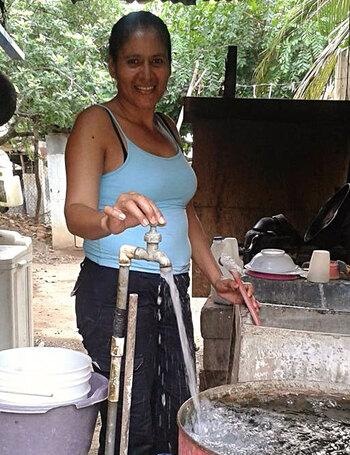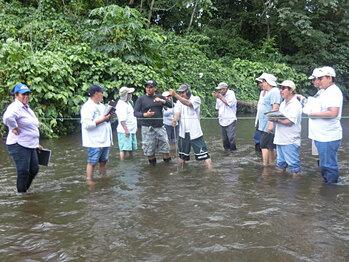Context
Nicaragua has managed to meet its drinking water target under the Millennium Development Goals: the country reduced the proportion of the population with no access to clean drinking water by half. In some cases, however, the water supply is still affected by severe shortages, especially in dry zones. In many areas, this precious resource flows through the pipes for just a few hours, and only on certain days of the week. Although the state water utility has improved its service, it does not reach all parts of the country. The rural water supply is in a precarious condition.
Wastewater disposal is also inadequate, both in towns and in the countryside. There is a lack of properly operated wastewater treatment plants in major urban centres, and a lack of adapted toilet systems in rural communities. Large quantities of wastewater thus end up untreated in rivers and lakes, causing problems for both the environment and the local population.
Extreme weather events caused by climate change and inadequate management of water resources and wastewater are leading to shortages and conflicts over water use. They are also giving rise to public health hazards and threatening economic development in the affected regions.
Objective
Water resources management and the municipal drinking water supply and sanitation systems are improved.
Approach
The programme is helping to establish an environmentally sound, fair and efficient water management system through advisory services and infrastructure measures. In order to improve access to affordable and adequate drinking water and sanitation services in the long term, the project is following the approach of integrated water resource management. This approach addresses the needs of all users and the components of water balance, requirements and demand, supply, water resources protection and climate change adaptation in a water catchment area.
The activities are also leading to an improvement in the services of the national state water utility ENACAL, the Nicaraguan Institute for Territorial Studies INETER and the Emergency Social Investment Fund FISE.
The focus is on urban drinking water supply and wastewater disposal, rural drinking water and sanitation supply, and integrated water resources management. In this context, the project offers training courses for employees of the state water utility, supplementing the national investment programme PISASH.
In addition, it supports the rehabilitation of existing drinking water supply systems, the construction of new systems and the installation of adapted latrines in the upper catchment area of the Río Coco. This comprises corresponding hydrological, hydrogeological and geophysical measures, as well as capacity building and awareness raising measures.
To begin with, the project is drawing up a plan for integrated water resources management together with the stakeholders, in particular the communities involved and the catchment area committee. It will then implement the most important measures for climate-sensitive and sustainable management and for the protection of water resources.
The project is supporting the National Forestry Institute in introducing agroforestry systems and the Institute for Territorial Studies in expanding water body monitoring and setting up a digital platform for the purpose of bundling and processing all data of relevance to water management. This improves the availability of the data for regional and national planning while increasing the informative value and quality of the national water management plan.

